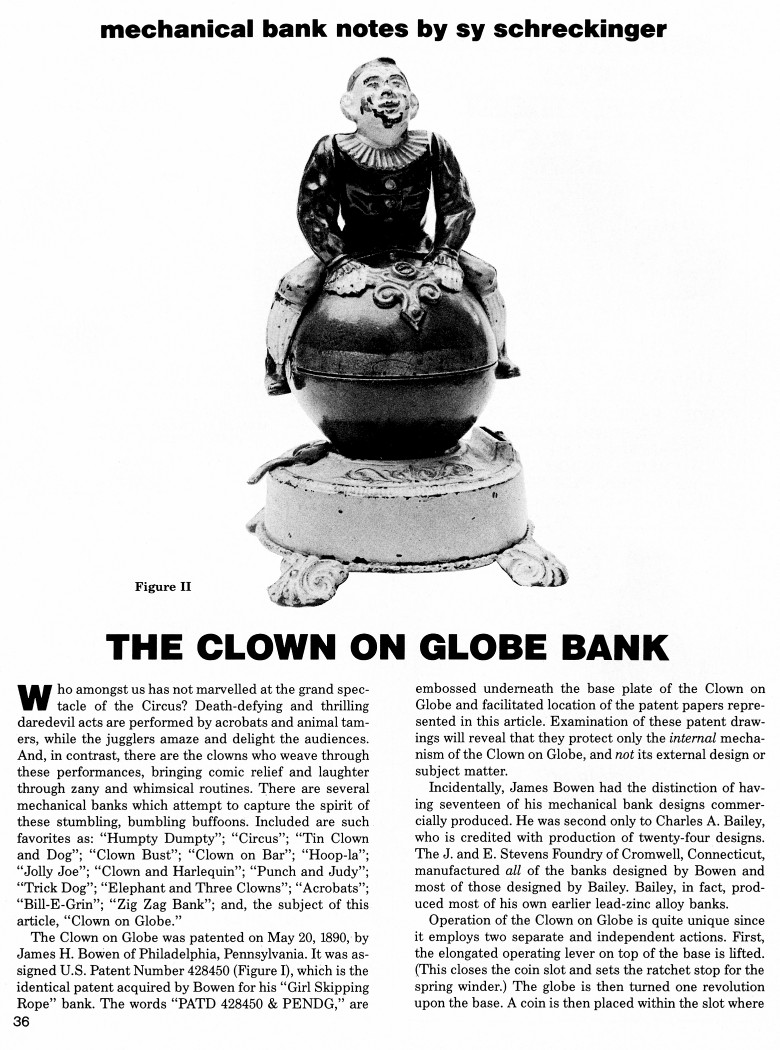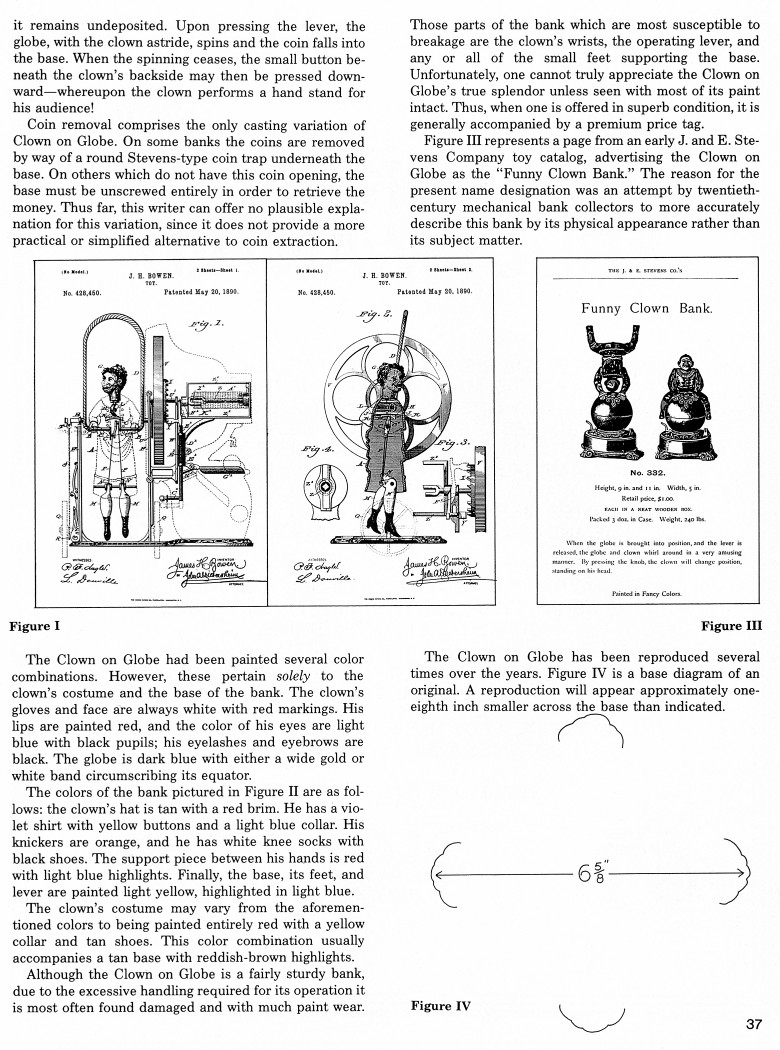|
The Clown on Globe Bank
by Sy Schreckinger – ANTIQUE TOY WORLD Magazine – November,
1987
Who amongst us has
not marveled at the grand spectacle of the Circus? Death-defying and
thrilling daredevil acts are performed by acrobats and animal tamers,
while the jugglers amaze and delight the audiences. And, in contrast,
there are the clowns who weave through these performances, bringing comic
relief and laughter through zany and whimsical routines. There are several
mechanical banks which attempt to capture the spirit of these stumbling,
bumbling buffoons. Included are such favorites as: "Humpty Dumpty";
"Circus"; "Tin Clown and Dog"; "Clown Bust"; "Clown on Bar"; "Hoop-la";
"Jolly Joe"; "Clown and Harlequin"; "Punch and Judy"; "Trick Dog";
"Elephant and Three Clowns"; "Acrobats"; " Bill-E -Grin"; "Zig Zag Bank";
and, the subject of this article, "Clown on Globe."
The Clown on Globe was patented on May 20, 1890, by James H. Bowen of
Philadelphia, Pennsylvania. It was assigned U.S. Patent Number
428,450
(Figure I), which is the identical patent acquired by Bowen for his "Girl
Skipping Rope" bank. The words "PATD 428450 & PENDG," are embossed
underneath the base plate of the Clown on Globe and facilitated location
of the patent papers represented in this article. Examination of these
patent drawings will reveal that they protect only the internal mechanism
of the Clown on Globe, and not its external design or subject matter.
Incidentally, James Bowen had the distinction of having seventeen of
his mechanical bank designs commercially produced. He was second only to
Charles A. Bailey, who is credited with production of twenty-four designs.
The J. and E. Stevens Foundry of Cromwell, Connecticut, manufactured all
of the banks designed by Bowen and most of those designed by Bailey.
Bailey, in fact, produced most of his own earlier lead-zinc alloy banks.
Operation of the Clown on Globe is quite unique since it employs two
separate and independent actions. First, the elongated operating lever on
top of the base is lifted. (This closes the coin slot and sets the ratchet
stop for the spring winder.) The globe is then turned one revolution upon
the base. A coin is then placed within the slot where it remains
undeposited. Upon pressing the lever, the globe, with the clown astride,
spins and the coin falls into the base. When the spinning ceases, the
small button beneath the clown's backside may then be pressed
downward — whereupon the clown performs a hand stand for his audience!
Coin removal comprises the only casting variation of Clown on Globe.
On some banks the coins are removed by way of a round Stevens-type coin
trap underneath the base. On others which do not have this coin opening,
the base must be unscrewed entirely in order to retrieve the money. Thus
far, this writer can offer no plausible explanation for this variation,
since it does not provide a more practical or simplified alternative to
coin extraction.
The Clown on Globe had been painted several color combinations.
However, these pertain solely to the clown's costume and the base of the
bank. The clown's gloves and face are always white with red markings. His
lips are painted red, and the color of his eyes are light blue with black
pupils; his eyelashes and eyebrows are black. The globe is dark blue with
either a wide gold or white band circumscribing its equator.
The colors of the bank pictured in Figure II are as follows: the
clown's hat is tan with a red brim. He has a violet shirt with yellow
buttons and a light blue collar. His knickers are orange, and he has white
knee socks with black shoes. The support piece between his hands is red
with light blue highlights. Finally, the base, its feet, and lever are
painted light yellow, highlighted in light blue.
The clown's costume may vary from the aforementioned
colors to being painted entirely red with a yellow collar and tan shoes.
This color combination usually accompanies a tan base with reddish-brown
highlights.
Although the Clown on Globe is a fairly sturdy bank, due to the
excessive handling required for its operation it is most often found
damaged and with much paint wear. Those parts of the bank which are most
susceptible to breakage are the clown's wrists, the operating lever, and
any or all of the small feet supporting the base. Unfortunately, one
cannot truly appreciate the Clown on Globe's true splendor unless seen
with most of its paint intact. Thus, when one is offered in superb
condition, it is generally accompanied by a premium price tag.
Figure III represents a page from an early J. and E. Stevens Company
toy catalog, advertising the Clown on Globe as the "Funny Clown Bank." The
reason for the present name designation was an attempt by
twentieth-century mechanical bank collectors to more accurately describe
this bank by its physical appearance rather than its subject matter.
The Clown on Globe has been reproduced several times over the years.
Figure IV is a base diagram of an original. A reproduction will appear
approximately one-eighth inch smaller across the base than indicated.
|


